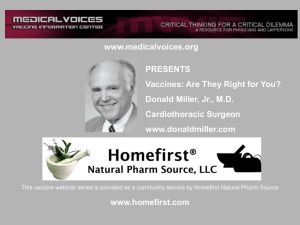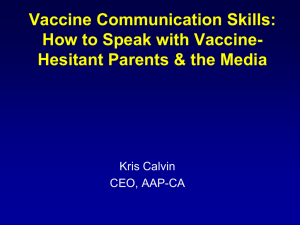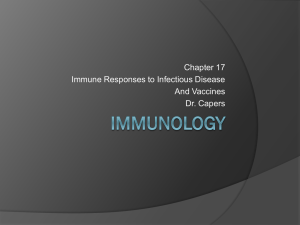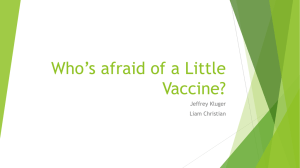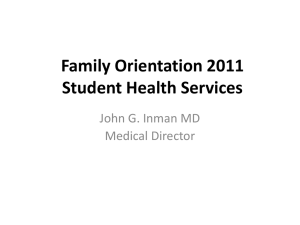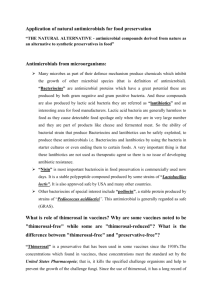Immunization protects future generations
advertisement
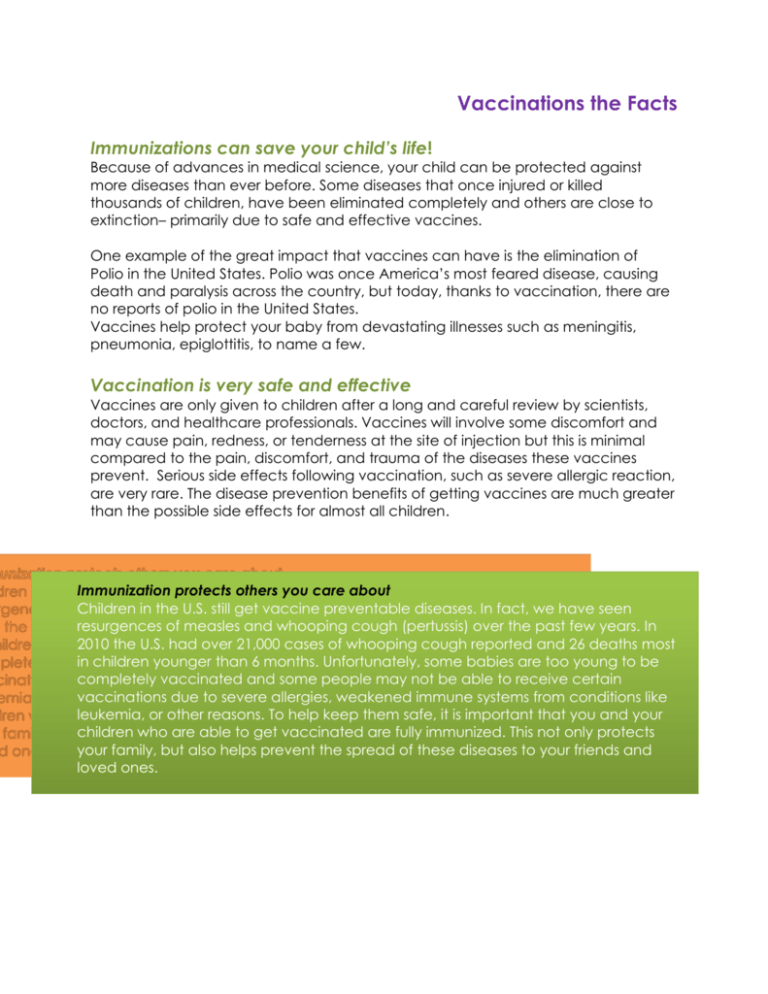
Vaccinations the Facts Immunizations can save your child’s life! Because of advances in medical science, your child can be protected against more diseases than ever before. Some diseases that once injured or killed thousands of children, have been eliminated completely and others are close to extinction– primarily due to safe and effective vaccines. One example of the great impact that vaccines can have is the elimination of Polio in the United States. Polio was once America’s most feared disease, causing death and paralysis across the country, but today, thanks to vaccination, there are no reports of polio in the United States. Vaccines help protect your baby from devastating illnesses such as meningitis, pneumonia, epiglottitis, to name a few. Vaccination is very safe and effective Vaccines are only given to children after a long and careful review by scientists, doctors, and healthcare professionals. Vaccines will involve some discomfort and may cause pain, redness, or tenderness at the site of injection but this is minimal compared to the pain, discomfort, and trauma of the diseases these vaccines prevent. Serious side effects following vaccination, such as severe allergic reaction, are very rare. The disease prevention benefits of getting vaccines are much greater than the possible side effects for almost all children. Immunization protects others you care about Children in the U.S. still get vaccine preventable diseases. In fact, we have seen resurgences of measles and whooping cough (pertussis) over the past few years. In 2010 the U.S. had over 21,000 cases of whooping cough reported and 26 deaths most in children younger than 6 months. Unfortunately, some babies are too young to be completely vaccinated and some people may not be able to receive certain vaccinations due to severe allergies, weakened immune systems from conditions like leukemia, or other reasons. To help keep them safe, it is important that you and your children who are able to get vaccinated are fully immunized. This not only protects your family, but also helps prevent the spread of these diseases to your friends and loved ones. Immunization protects future generations Vaccines have reduced and, in some cases, eliminated many diseases that killed or severely disabled people just a few generations ago. For example, smallpox vaccination eradicated that disease worldwide. Your children don’t have to get smallpox shots anymore because the disease no longer exists. By vaccinating children against rubella (German measles), the risk that pregnant women will pass this virus on to their fetus or newborn has been dramatically decreased, and birth defects associated with that virus no longer are seen in the United States. The Myths The MMR vaccine causes Autism. One small case report of only eight patients in 1998 led a research group to feel that the combination measles, mumps, and rubella (MMR) vaccine might cause autism.11 But, don’t try to find the article online because the journal that published it later retracted it when a former member of the research lab revealed that the data reported in the study was fabricated! Twelve years later, the lead author lost his license to practice medicine in England and was accused of fraud. The whole thing was a hoax. One of the criteria used to make a diagnosis of autism is a language delay. Because children do not have significant expressive language under a year of age, doctors have to wait until 15 to 18 months to confirm a language delay and make the diagnosis. That’s about the same time as the MMR vaccination, which leads some parents to wonder about autism and vaccination. THERE IS NO EMPIRICAL DATA TO SUGGEST LINK TO AUTISM! It is overwhelming to a child’s immune system to give so many shots in one visit. Infants and children are exposed to many germs every day just by playing, eating, and breathing. Their immune systems fight those germs, also called antigens, to keep the body healthy. The amount of antigens that children fight every day (2,0006,000) is much more than the antigens in any combination of vaccines on the current schedule (150 for the whole schedule). So children’s immune systems are not overwhelmed by vaccines. It is better and safer to spread out the vaccines. Many, doctors, scientists, and researchers work together with the CDC to decide what is the best timing to give shots. The goal: Protect babies as soon as it is safe and effective to do so. This schedule was not created out of thin air. There is absolutely no research that says delaying certain shots is safer. What we do know about alternative vaccination schedules is that delaying shots is playing Russian roulette with your child. The simple truth is that you are leaving your child unprotected, at a time when she is the most vulnerable. Mercury preservatives is found in all vaccines and is harmful Only a few vaccines with mercury remain. Preservatives and stabilizers are used in vaccines so the vaccinations remain potent and uncontaminated. Thimerosal was removed from all vaccines given to infants younger than age 6 months by 2001. This deserves repeating: Your young baby will not be getting vaccines that contain mercury (thimerosal) as a preservative. The one exception is the influenza vaccine that is found in multi-dose vials that need a preservative to prevent contamination. Despite the fact that most vaccines are mercury preservative free now, speculation persists about vaccines previously containing mercury and links to autism. This speculation continues even after the Institute of Medicine (IOM) published a conclusive report in 2004 negating any association between vaccines and autism. Reality Check: Worried about the mercury preservative (thimerosal) in your child’s flu vaccine? Consider this: A tuna fish sandwich has five times more mercury than a thimerosal preserved flu vaccine. And the type of mercury (methylmercury) found in tuna is the one that has health concerns. Also, a baby who is exclusively breastfed for six months of life consumes about 0.36 mg of methyl mercury from breast milk. That’s 15 times the quantity of ethyl mercury in one flu vaccine. The small amount of aluminum salt preservative used in some vaccines is harmful. Yes, trace amounts of aluminum salts are used in some childhood vaccines. Here’s all you need to know (and more) about aluminum. Aluminum is everywhere. It’s the most common metal in our earth’s crust. So it is naturally present in our water, soil, and even in the air. Fruits, vegetables, nuts, flour, cereal, dairy products, and yes, even baby formula and breast milk...all contain some aluminum. Do you wear antiperspirant? It’s in there, too. To avoid aluminum exposure, you’d have to quit wearing antiperspirant … and basically leave the planet. Why is aluminum in some vaccines? Aluminum enhances the immune system’s response to the vaccine, therefore making it more effective.. It’s been used safely for several decades. By using aluminum salts, some inactivated vaccines require fewer booster shots for the body to mount an adequate immune response. So, are there any health concerns with aluminum in vaccines? No. The Formaldehyde in vaccines is harmful to the body Small amounts of formaldehyde are used to sterilize the vaccine fluid so your child doesn’t get something like flesh eating Strep bacteria when he gets his shots. We know when you think of formaldehyde, you think of that ever present smell wafting from the anatomy lab in high school. But what you probably don’t know is that formaldehyde is also a naturally occurring substance in your body. And if you use baby shampoo, paper towels or mascara, or have carpeting in your home, you’ve been exposed to formaldehyde. The small amount used in vaccines is not a health concern.
